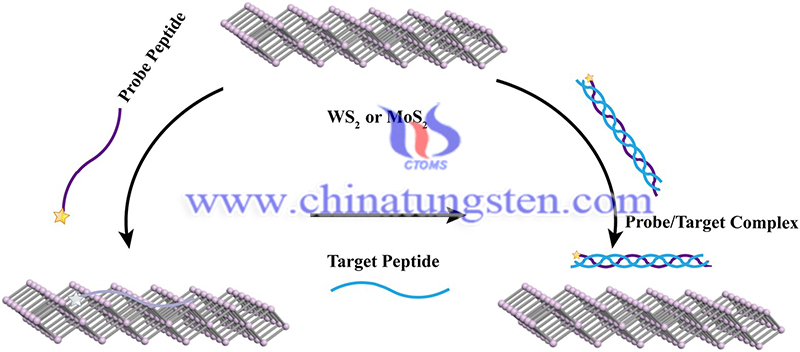Tungsten Disulfide Nanomaterials (WS2NM) for Biosensors – Ⅱ
- Details
- Category: Tungsten Information
- Published on Thursday, 11 August 2022 11:19
Tungsten disulfide nanomaterials can be successfully used in biosensors and nanomedicine, such as observation of DNA hybridization, enzymes, and proteins, as well as environmental contamination and medical diagnostics. For a long time, electrochemical biosensors, such as semiconductors and screen-printed electrodes, have been used for various applications in numerous fields.
In electrochemical-based biosensors, the amplification of electrochemical signals by NPS has led to the development of several nanohybrid compounds that can contribute to the formation of robust biosensor as a fast, simple, and sensitive method for biomolecule identification. Electroactive metallic tungsten (W) has been extensively used in electrochemical biosensor. By using one-step or sequential electrodeposition techniques, the electrical conductivity of WS2 can be improved by binding to conductive compounds, similar to metal nanoparticles such as gold, silver, and platinum.
![]()
(Picture source: Ouyang, Q/Nature)
The superior sensing performance of the proposed WS2- based sensor can be successfully used to observe DNA hybridization, enzymes, and proteins, as well as environmental contamination and medical diagnostics. Based on these facts, Ke-Jing Huang et al. proposed a straightforward approach for creating a robust and conductive interface for DNA hybridization based on electrochemical detection. The study demonstrates a dual-signal amplification platform built on a combination of tungsten sulfide-graphene (WS 2 -Gr) composites and gold nanoparticles (AuNPs).
Since the structure and properties of WS2-Gr and AuNPs are not altered by the DNA-mediated non-covalent assembly of this nanostructure, ssDNA-AuNPs/WS2-Gr can better maintain the obtained conductivity. This dual-signal amplification approach is able to distinguish single/tris-base mismatched DNA sequences with remarkable selectivity, which can facilitate the detection of target DNA up to femtomolar magnitude.
Their linear range of detectable DNA concentration was four times higher than other methods. In another study, a biosurfactant was used to functionalize biomolecules and provide stability to tungsten disulfide quantum dots. In addition to requiring a lower rate of toxic chemical application, their process also used the functionalized QD for the immobilization of ferritin antibodies. The results of this study show that their immunosensor achieves the appropriate selectivity, stability, and dynamic linear range.
These QDs-functionalized electrodes prove to be quite suitable for creating portable or point-of-care devices. This platform can facilitate the observation of a wide range of additional diagnostic indicators by simply switching the target bioreceptor, which is important in medicine. However, the main obstacle to this approach is the availability of biosurfactants for the synthesis of quantum dots. Therefore, there is a need to scale up the production of biosurfactants.

(Picture source: Sun, X/Nature)
The combination of quantum dots with nanoparticles produces a semiconductor that is used as an electrochemical modifier to improve the sensitivity of biosensors for protein detection. ramin Pourakbari et al. developed a new biosensing technique for the rapid and accurate detection of c-Met proteins through the action of tungsten disulfide quantum dots (WS2 QDs)-AU. Their study involved the modified electrochemical deposition of AuNPs functionalized with WS2 QDs on GCE (glassy carbon electrodes).
Thereafter, the c-Met phage was immobilized on a modified electrode and applied for the detection of c-Met protein (colon cancer biomarker) by an electrochemical biosensor. The characteristics of the newly developed cell-based electrochemical sensor, such as lack of labeling requirements, high sensitivity, simplicity, rapidity, non-toxicity, and reusability, lead to its powerful application in the overall in vitro toxicity assessment.
Cited article: Niknam S., Ahmad Dehdast S., Pourdakan O., Shabani M., Kazem Koohi M. Tungsten Disulfide Nanomaterials (WS2NM) Application in Biosensors and Nanomedicine, A review. Nanomed Res J, 2022; 7(3): 214-226. DOI: 10.22034/nmrj.2022.03.001
- Tungsten Manufacturer & Supplier, Chinatungsten Online: www.chinatungsten.com
- Tungsten News & Prices of China Tungsten Industry Association: www.ctia.com.cn
- Molybdenum News & Price: news.molybdenum.com.cn
- Tel.: 86 592 5129696; Fax: 86 592 5129797; Email: sales@chinatungsten.com



 sales@chinatungsten.com
sales@chinatungsten.com